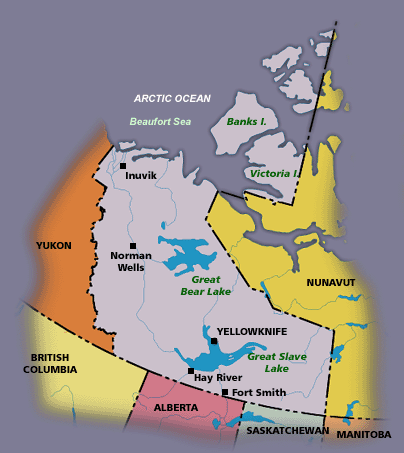Northwest Territories
Pray:
- Pray for the Aglow groups and leaders to be strengthened.
- Pray for all the resources and creativity needed to fulfill the intentions of God in the province of Northwest Territories.
- Pray for the Aglow prayer group in the Capital city.
- Pray for godly government leaders. Blessed is the nation whose God is The Lord, the people whom He has chosen for His own inheritance. Psalm 33:12
Proclaim:
- Arise, shine; for your light has come! And the glory of the LORD is risen upon you. For behold, the darkness shall cover the earth, and deep darkness the people; but the LORD will arise over you, and His glory will be seen upon you. Isaiah 60:1,2 (NKJV)
- Lift up your heads, O you gates! Lift up, you everlasting doors! And the King of glory shall come in. Who is this King of glory? The Lord of hosts, He is he King of glory. Psalm 24:9-10 (NKJV)
Interesting Facts About Northwest Territories
Government: The N.W.T. government has the same general responsibilities as provincial governments: taxation, municipal bodies, education, wildlife, health and hospital services, forest management, housing, social services and economic development.
As a Territory the NWT does not have full provincial status, although it achieved a style of government similar to that of the provinces in 1979. The Canadian government retains administrative control over water, land and forestry and the development of all non-renewable resources (i.e. minerals, oil and gas).
The issue of settling Aboriginal land claims in the N.W.T. emerged in the 1970s. In 1984 a final agreement was reached with the Inuvialuit of the western Arctic; it provided some 2500 people with 91 000 km2 of land, financial compensation, social development funding, hunting rights and a greater role in wildlife management, conservation and environmental protection. In 1992, the Gwich’in settled a comprehensive land claim that provided 22,422 km2 of land in the Yukon; subsurface rights; a share in the resource royalties derived from the Mackenzie River Valley; tax-free capital transfers; hunting rights; a greater role in the management of wildlife, land and the environment; and the right of first refusal on a variety of activities related to wildlife.
The settling of northern land claims sets the stage for increased economic activity in which all can share and have a voice. However, development, which is welcome and necessary for economic prosperity, will need to be managed so as not to threaten the fragile Arctic ecosystem and the traditional lifestyles of the northern peoples.
The year 1993 saw the conclusion of the Nunavut land claims agreement, the largest land claim ever settled in Canada. The agreement divided the NWT east and west and gave the Inuit of the eastern Arctic control of more than 350 000 km2 of land. In April 1999 the former Northwest Territories was divided, creating the new territory of Nunavut.
People: The present population of the N.W.T. is approximately 40,000 Dene, Inuvialuit and Métis make up 48%, non-Aboriginals about 52%. Most live in small communities; Yellowknife, the capital, has a population of more than 15 000.
History: The ancestors of the present day Dene peoples lived along the Mackenzie Valley in the N.W.T. 10,000 years ago. The first Inuit are believed to have crossed the Bering Strait about 5,000 years ago, spreading east along the Arctic coast. In 1789, Alexander Mackenzie ‘discovered’ the Mackenzie River and followed it to its mouth at the Arctic Ocean. Fur traders soon established posts in the Mackenzie River basin. Late in the next century religious missions were founded in the area. The Europeans reshaped the North bringing with them a new economy and way of life. Through the following years communities grew around trading posts, mission schools and Royal Canadian Mounted Police (RCMP) stations.
In 1870, the British government transferred control of the North-Western Territory to Canada. Ten years later the British government annexed the islands of the Arctic Archipelago that also became part of the North West Territories.
In 1905, both Alberta and Saskatchewan were created from the Northwest Territories landbase. Finally in 1912, the provinces of Manitoba, Ontario and Quebec were enlarged, fixing the Northwest Territories with a size and shape that remained unchanged until 1999, when Nunavut was established. By World War II, mineral exploration and the military were playing a role in northern development, prompting a more active interest in the N.W.T. by the rest of Canada.
Interesting Facts information from the library.educationworld.net/canadafacts website. Read more about the Northwest Territories



Good evening, Aglow International. Please pray that I recover my box full of recorded Mini DV Tapes that has sentimental values attached to me. It would mean the world to me if you prayed that I recover them in somewhat different ways. Thanks in advance.